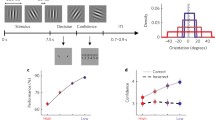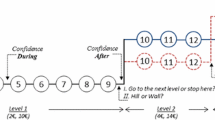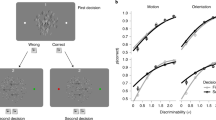Abstract
Understanding fraction magnitudes is especially important in daily life, but fraction reasoning is quite difficult. To accurately reason about fraction magnitudes, adults need to monitor what they know and what they do not know. However, little is known about which cues adults use to monitor fraction performance. Across two studies, we examined adults’ trial-by-trial fraction estimates, confidence judgments, and ratings of fraction familiarity. Adults were more confident when their estimates were more precise as well as when estimating fractions they rated as more familiar. However, adults judged their confidence in estimating fraction magnitudes, in part, based on their familiarity with each fraction. The role familiarity cues play in judgments of confidence with fractions suggests that people may be less likely to check for errors when reasoning about highly-familiar fractions.

Similar content being viewed by others
Notes
We acknowledge that there is an ongoing debate as to which measure of metacognitive accuracy is best (Fleming and Lau 2014; Higham and Higham 2019). However, we chose to calculate gamma given the similarities between gamma and other signal-detection measures of metacognitive sensitivity (Higham and Higham 2019). Furthermore, gamma is appropriate for our continuous measure of number line estimation precision, whereas signal-detection analyses such as AROC require a dichotomized response (e.g., correct/incorrect), and PAE is a continuous measure of performance.
References
Ackerman, R., & Koriat, A. (2011). Response latency as a predictor of the accuracy of children's reports. Journal of Experimental Psychology: Applied, 17(4), 406–417.
Alibali, M. W., & Sidney, P. G. (2015). Variability in the natural number bias: Who, when, how, and why. Learning and Instruction, 37, 56–61.
Alter, A. L., & Oppenheimer, D. M. (2009). Uniting the tribes of fluency to form a metacognitive nation. Personality and Social Psychology Review, 13(3), 219–235.
Bates, D., Maechler, M., Bolker, B., & Walker, S. (2015). Fitting linear mixed-effects models using lme4. Journal of Statistical Software, 67(1), 1–48. https://doi.org/10.18637/jss.v067.i01.
Bjork, R. A., Dunlosky, J., & Kornell, N. (2013). Self-regulated learning: Beliefs, techniques, and illusions. Annual Review of Psychology, 64, 417–444.
Braithwaite, D. W., & Siegler, R. S. (2017). Developmental changes in the whole number bias. Developmental Science, 21(2).
Braithwaite, D. W., & Siegler, R. S. (2018). Children learn spurious associations in their math textbooks: Examples from fraction arithmetic. Journal of Experimental Psychology: Learning, Memory, and Cognition, 44(11), 1765–1777.
Braithwaite, D. W., Pyke, A. A., & Siegler, R. S. (2017). A computational model of fraction arithmetic. Psychological Review, 124(5), 603–625.
Braithwaite, D. W., Leib, E. R., Siegler, R. S., & McMullen, J. (2019). Individual differences in fraction arithmetic learning. Cognitive Psychology, 112, 81–98.
Dehaene, S., & Mehler, J. (1992). Cross-linguistic regularities in the frequency of number words. Cognition, 43(1), 1–29.
Dumas, J. E., Johnson, M., & Lynch, A. M. (2002). Likableness, familiarity, and frequency of 844 person-descriptive words. Personality and Individual Differences, 32(3), 523–531.
Dunlosky, J., & Metcalfe, J. (2008). Metacognition. Sage Publications.
Dunlosky, J., & Rawson, K. A. (2012). Overconfidence produces underachievement: Inaccurate self evaluations undermine students’ learning and retention. Learning and Instruction, 22(4), 271–280.
Eason, S. H., & Ramani, G. B. (2018). Parent–child math talk about fractions during formal learning and guided play activities. Child Development., 91, 546–562. https://doi.org/10.1111/cdev.13199.
Fazio, L. K., DeWolf, M., & Siegler, R. S. (2016). Strategy use and strategy choice in fraction magnitude comparison. Journal of Experimental Psychology: Learning, Memory, and Cognition, 42(1), 1.
Finn, B., & Tauber, S. K. (2015). When confidence is not a signal of knowing: How students’ experiences and beliefs about processing fluency can lead to miscalibrated confidence. Educational Psychology Review, 27(4), 567–586.
Fitzsimmons, C. J., Thompson, C. A., & Sidney, P. G. (in press). Do adults treat equivalent fractions equally? Adults’ strategies and errors during fraction reasoning. Journal of Experimental Psychology: Learning, Memory, and Cognition.
Fleming, S. M., & Lau, H. C. (2014). How to measure metacognition. Frontiers in Human Neuroscience, 8, 443.
Gentner, D. (1983). Structure-mapping: A theoretical framework for analogy. Cognitive Science, 7(2), 155–170.
Gunderson, E. A., & Levine, S. C. (2012). Some types of parent number talk count more than others: Relations between parents’ input and children’s cardinal-number knowledge. Developmental Science, 14(5), 1021–1032.
Hall, C. C., Ariss, L., & Todorov, A. (2007). The illusion of knowledge: When more information reduces accuracy and increases confidence. Organizational Behavior and Human Decision Processes, 103(2), 277–290.
Handel, M. J. (2016). What do people do at work? Journal for Labour Market Research, 49(2), 177–197.
Hertzog, C., Dunlosky, J., Robinson, A. E., & Kidder, D. P. (2003). Encoding fluency is a cue used for judgments about learning. Journal of Experimental Psychology: Learning, Memory, and Cognition, 29(1), 22.
Higham, P. A., & Higham, D. P. (2019). New improved gamma: Enhancing the accuracy of Goodman–Kruskal’s gamma using ROC curves. Behavior Research Methods, 51(1), 108–125.
Jaeger, A. J., & Wiley, J. (2014). Do illustrations help or harm metacomprehension accuracy? Learning and Instruction, 34, 58–73.
Koriat, A. (1997). Monitoring one's own knowledge during study: A cue-utilization approach to judgments of learning. Journal of Experimental Psychology: General, 126(4), 349–370.
Koriat, A. (2008). When confidence in a choice is independent of which choice is made. Psychonomic Bulletin & Review, 15(5), 997–1001.
Koriat, A., & Levy-Sadot, R. (2001). The combined contributions of the cue-familiarity and accessibility heuristics to feelings of knowing. Journal of Experimental Psychology: Learning, Memory, and Cognition, 27(1), 34.
Koriat, A., Ackerman, R., Adiv, S., Lockl, K., & Schneider, W. (2014). The effects of goal-driven and data-driven regulation on metacognitive monitoring during learning: A developmental perspective. Journal of Experimental Psychology: General, 143(1), 386–403.
Levine, S. C., Suriyakham, L. W., Rowe, M. L., Huttenlocher, J., & Gunderson, E. A. (2010). What counts in the development of young children's number knowledge? Developmental Psychology, 46(5), 1309–1319.
Metcalfe, J. (2009). Metacognitive judgments and control of study. Current Directions in Psychological Science, 18(3), 159–163.
Mueller, M. L., & Dunlosky, J. (2017). How beliefs can impact judgments of learning: Evaluating analytic processing theory with beliefs about fluency. Journal of Memory and Language, 93, 245–258.
Mueller, M. L., Dunlosky, J., Tauber, S. K., & Rhodes, M. G. (2014). The font-size effect on judgments of learning: Does it exemplify fluency effects or reflect people’s beliefs about memory? Journal of Memory and Language, 70, 1–12.
Nelson, T. O. (1984). A comparison of current measures of the accuracy of feeling-of-knowing predictions. Psychological Bulletin, 95(1), 109–133.
Nelson, L. J., & Fyfe, E. R. (2019). Metacognitive monitoring and help-seeking decisions on mathematical equivalence problems. Metacognition and Learning, 14, 1–21. https://doi.org/10.1007/s11409-019-09203-w.
Ni, Y., & Zhou, Y. D. (2005). Teaching and learning fraction and rational numbers: The origins and implications of whole number bias. Educational Psychologist, 40(1), 27–52.
O'Leary, A. P., & Sloutsky, V. M. (2016). Carving metacognition at its joints: Protracted development of component processes. Child Development, 88(3), 1015–1032.
O'Leary, A. P., & Sloutsky, V. M. (2018). Components of metacognition can function independently across development. Developmental Psychology, 55(2), 315.
Opfer, J. E., & DeVries, J. M. (2008). Representational change and magnitude estimation: Why young children can make more accurate salary comparisons than adults. Cognition, 108(3), 843–849.
Peters, E., Västfjäll, D., Slovic, P., Mertz, C. K., Mazzocco, K., & Dickert, S. (2006). Numeracy and decision making. Psychological Science, 17(5), 407–413.
Peters, E., Hibbard, J., Slovic, P., & Dieckmann, N. (2007). Numeracy skill and the communication, comprehension, and use of risk-benefit information. Health Affairs, 26(3), 741–748.
Peters, E., Tompkins, M. K., Knoll, M. A., Ardoin, S. P., Shoots-Reinhard, B., & Meara, A. S. (2019). Despite high objective numeracy, lower numeric confidence relates to worse financial and medical outcomes. Proceedings of the National Academy of Sciences, 116(39), 19386–19391.
R Core Team. (2015). R: A language and environment for statistical computing. In R Foundation for statistical computing. Vienna: Austria. URL http://www.R-project.org/.
Ramani, G. B., & Siegler, R. S. (2008). Promoting broad and stable improvements in low-income children’s numerical knowledge through playing number board games. Child Development, 79(2), 375–394.
Ramani, G. B., Siegler, R. S., & Hitti, A. (2012). Taking it to the classroom: Number board games as a small group learning activity. Journal of Educational Psychology, 104(3), 661–672.
Reder, L. M., & Ritter, F. E. (1992). What determines initial feeling of knowing? Familiarity with question terms, not with the answer. Journal of Experimental Psychology: Learning, Memory, and Cognition, 18(3), 435.
Sidney, P. G., Thalluri, R., Buerke, M. L., & Thompson, C. A. (2018). Who uses more strategies? Linking mathematics anxiety to adults’ strategy variability and performance on fraction magnitude tasks. Thinking & Reasoning, 1–38.
Siegler, R. S., & Booth, J. L. (2004). Development of numerical estimation in young children. Child Development, 75(2), 428–444.
Siegler, R. S., & Opfer, J. E. (2003). The development of numerical estimation: Evidence for multiple representations of numerical quantity. Psychological Science, 14(3), 237–250.
Siegler, R. S., & Pyke, A. A. (2013). Developmental and individual differences in understanding of fractions. Developmental Psychology, 49(10), 1994–2004.
Siegler, R. S., & Ramani, G. B. (2008). Playing linear numerical board games promotes low-income children's numerical development. Developmental Science, 11(5), 655–661.
Siegler, R. S., Thompson, C. A., & Schneider, M. (2011). An integrated theory of whole number and fractions development. Cognitive Psychology, 62(4), 273–296.
Siegler, R. S., Duncan, G. J., Davis-Kean, P. E., Duckworth, K., Claessens, A., Engel, M., Susperreguy, M. I., & Chen, M. (2012). Early predictors of high school mathematics achievement. Psychological Science, 23(7), 691–697.
Tekin, E., & Roediger, H. L. (2017). The range of confidence scales does not affect the relationship between confidence and accuracy in recognition memory. Cognitive Research: Principles and Implications, 2(1), 49.
Tekin, E., Lin, W., & Roediger, H. L. (2018). The relationship between confidence and accuracy with verbal and verbal+ numeric confidence scales. Cognitive Research: Principles and Implications, 3(1), 41.
Thiede, K. W., Griffin, T. D., Wiley, J., & Anderson, M. C. (2010). Poor metacomprehension accuracy as a result of inappropriate cue use. Discourse Processes, 47(4), 331–362.
Torbeyns, J., Schneider, M., Xin, Z., & Siegler, R. S. (2015). Bridging the gap: Fraction understanding is central to mathematics achievement in students from three different continents. Learning and Instruction, 37, 5–13.
Wall, J., Thompson, C., & Morris, B. J. (2015). Confidence judgments and eye fixations reveal adults' fractions knowledge. In D. C. Noelle, R. Dale, A. S. Warlaumont, J. Yoshimi, T. Matlock, C. D. Jennings, & P. P. Maglio (Eds.), Proceedings of the 37th annual meeting of the cognitive science society (pp. 2571–2576). Austin: Cognitive Science Society.
Wall, J. L., Thompson, C. A., Dunlosky, J., & Merriman, W. E. (2016). Children can accurately monitor and control their number-line estimation performance. Developmental Psychology, 52(10), 1493–1502.
Funding
Support for this research was provided in part by the U.S. Department of Education, Institute of Education Sciences grant R305A160295 to Dr. Clarissa A. Thompson and the Kent State University Judie Fall Lasser Award to Charles J. Fitzsimmons.
Author information
Authors and Affiliations
Corresponding author
Ethics declarations
Conflict of interest
The authors declare that they have no conflict of interest.
Additional information
Publisher’s note
Springer Nature remains neutral with regard to jurisdictional claims in published maps and institutional affiliations.
Part of this report was accepted as a conference proceeding to the North American Chapter of the International Group for the Psychology of Mathematics Education (PME-NA, 2019). The authors retain full copyrights of the submission. Pre-registrations and project information can be viewed here: https://osf.io/4uygd/.
Electronic supplementary material
ESM 1
(PDF 210 kb)
Appendix
Appendix
Rights and permissions
About this article
Cite this article
Fitzsimmons, C.J., Thompson, C.A. & Sidney, P.G. Confident or familiar? The role of familiarity ratings in adults’ confidence judgments when estimating fraction magnitudes. Metacognition Learning 15, 215–231 (2020). https://doi.org/10.1007/s11409-020-09225-9
Received:
Accepted:
Published:
Issue Date:
DOI: https://doi.org/10.1007/s11409-020-09225-9




